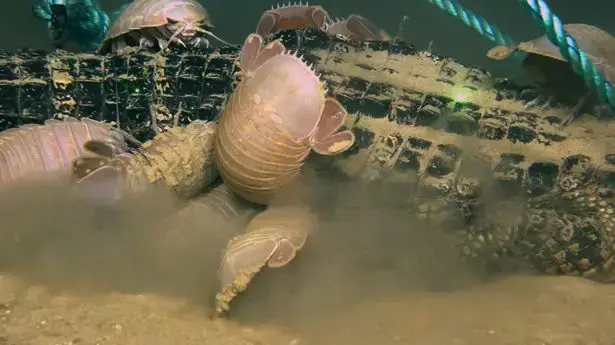The experiment that exposed the zombie-worm: a new species of bone-eating worm - eliminating alligators
Three alligator carcasses were dumped into the deep waters of the Gulf of Mexico as part of a carbon cycle experiment. One was eaten by crabs, the other disappeared after apparently being devoured by a huge shark and the third found a new species of worm
The experiment that exposed the zombie-worm: a new species of bone-eating worm - eliminating alligators
LUMCONIn the first trial of its kind, three carcasses of alligators were thrown into the deep waters of the Gulf of Mexico. One is eaten by crabs, the other is eaten by an animal that looks like an armadillo and is actually a new species of bone-eating worm and the third mysteriously disappears, probably swallowed whole by a huge shark. The researchers, who just wanted to check the carbon cycle combined between land animal and marine life, were surprised by the fate of the last two alligators, with their third fate unable to determine for sure.
Dr. Craig McClain of the Louisiana Marine Consortium, who led the experiment, said it was impossible to determine what was going on with the alligator that disappeared, though he believed it was one of two sharks: the Greenlandic Shark, which reaches 6.4 meters and has a life span of 300 to 500 A year - or a six gray shark that can reach its height of 8 meters and is known to feed on scavengers - just eight days since being thrown into the water, the alligator is gone when all that remains is dragging marks (about 10 meters) on the sand, rope and weight that lowered it down "We have no photographic evidence to prove the fate of this alligator," Dr. McClain said, "through a process of reasoning No options, we think one of these two species of sharks is the most likely candidate, but that's just a hypothesis right now. "
More in Walla! NEWS More in Walla! NEWSIsrael will look completely different by 2040. Watch
In cooperation with JNF
To the full articleThat's all that's left of it: rope, weight and drag marks
Alligator is fully eaten during an experiment (Photo: Screenshot)
The second alligator is almost completely eaten in 51 days, with all that's left is some bones. It is eaten by large crabs called isopods (the size of a soccer ball), which have been documented surrounding the carcass. These managed to penetrate the hard layer of his skin and feed on his soft tissue. After they untied skin and bones, it was the worm's turn to dine. The researchers found a new species of alligator in what they called a "zombie-worm" that settles on the bones and feeds on the lipids inside. The new species comes from the Osdex family, who have never been seen in the area before and have never been fed by the bones of the crocodiles.
The last alligator was devoured by deep-water crabs, which also surprised researchers as they expected the alligator's hard skin to prevent them from reaching the soft tissues.
The other alligator is eaten by isopods
The second alligator is eaten by isopods (Photo: screenshot)
The second alligator is eaten by isopods (Photo: screenshot)
And that's all that's left of him:
The second alligator is eaten by isopods (Photo: screenshot)
The three alligators were placed on the ocean floor at a depth of 2.5 miles below the surface of the water. The researchers expected to see how long the dead alligators would "survive" in the depths and how the starving marine creatures would respond when they were found. Dr McClane added: "We wanted to test and understand how the carbon cycle works through the oceans, as well as the links between the earth and the ocean in the carbon cycle. Given that large populations of alligators are most commonly found in coastal habitats, our team seeks to understand how their carcasses may serve as carbon sources in the deep oceans. How quickly can deep-sea organisms access and absorb this carbon. "







/cloudfront-eu-central-1.images.arcpublishing.com/prisa/KMEYMJKESBAZBE4MRBAM4TGHIQ.jpg)


